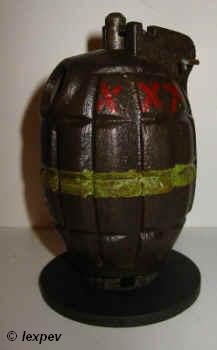|
|
| BRITISH EXPLOSIVE ORDNANCE |
| Part 5 - Chapter 2 |
| Anti-Personnel Grenades |
|
A./P. Rifle or Hand Grenade No. 36M Mk I (Obsolete) |
| Data |
|
Over-all length |
4 in. |
|
Diameter |
2.4 in. |
|
Total weight |
1 lb. 11¼ oz. (approx.) |
|
Filling |
Baratol |
|
Delay |
4 seconds for hand grenades; 7 seconds for rifle grenades |
|
Color |
Black |
|
Markings |
Green band around center; red band or crosses around top |
|
Description: This grenade consists of a lemon-shaped, cast-iron body filled with high explosive. The body has three holes in it; one in the base for priming, one near the top for filling, and one on the top through which the striker protrudes. The body is serrated and relatively thick, so as to give good fragmentation. A center piece, containing a stri-ker spring, a primer delay train, and a detonator, is located within the body and surroun-ded by cast explosive. |
|
The striker is held up and the striker spring is held cocked by a lever which fits into a slot in the top of the striker. The lever is secured by a safety pin passing over it and through holes in two shoulders, which project on the outside of the body. The lever is shaped with two small projections, which fit into notches in these shoulders to provide a pivot. The lever projects down the side of the grenade body, matching the body con-tour. The filling hole is closed by a screw plug. The base plug threads into the base ope-ning and is itself threaded to receive a 2.5-in. diameter metal gas check disc for use when the grenade is fired from the rifle projector. |
|
The igniter consists of a primer cap, a short length of safety fuse, and a detonator. The Igniters Mk V and Mk VI, which differ only in the composition of the safety fuse, in-corporate a 4-sec. delay for use with hand grenades. These igniters can be identified by the white safety fuse employed. The Igniters Mk II and Mk III incorporate a 7-sec. delay for use with rifle grenades. They can be identified by the yellow safety fuse used, and the fact that the detonator body of the Mk II is copper, while that of the Mk III is alumi-num. |
|
Operation: Priming consists of removing the base plug, inserting the igniter set, and replacing the base plug. |
|
When the grenade is to be thrown, it is held with the throwing hand over the safety lever, and the safety pin is then removed. When the grenade is thrown, the lever is re-leased. The striker spring forces the striker downward, rotating the lever about its pivot and throwing it off. The striker hits the cap igniting the delay, which, in turn, sets off the detonator and the main filling of the grenade. |
|
If the grenade is to be fired from a rifle discharger, it must be primed with the 7-se-cond igniter and the gas check disc must be threaded tightly into the base plug. The grenade is placed in the discharger, base first. When the grenade is inside the discharger and the striker lever is held by the sides of the discharger, the safety pin is removed. As the grenade is fired and leaves the discharger, the safety lever is no longer retained and flies off, allowing the striker to hit the cap. |
|
Remark: This grenade is packed and marked as a hand grenade with a 4-sec. delay igniter, or as a rifle grenade with a 7-sec. delay igniter. |
|
No weight of explosive is specified, as the grenade is filled to capacity. |
|
|
| Figure 232 – A./P. Rifle or Hand Grenade No. 36M Mk I |
|
|
|
|
|
 |
| A./P. Rifle Grenade No. 36M Mk I |